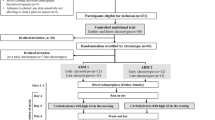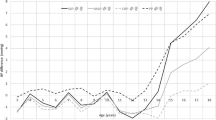Abstract
Background
Prolactin (PRL) has been proposed to play an important role in the pathophysiology of obesity. To further elucidate the relationship between PRL and obesity-related metabolic disturbances, we performed a large cross-sectional study and also reassessed serum PRL levels in a subsample ~1 year after gastric bypass surgery.
Methods
In the cross-sectional part of the study, we assessed basal serum PRL levels in 344 obese subjects (68% women; BMI mean ± SD, 44.3 ± 6.6 kg/m2; range 27.0–67.0 kg/m2) along with measurements of glucose, insulin, C-peptide, triglycerides, total cholesterol, LDL-cholesterol, HDL-cholesterol, high sensitive (hs) C-reactive protein, and fat mass assessed by bioelectrical impedance analysis. In 38 patients, we reassessed PRL levels ~1 year after they have undergone a gastric bypass operation.
Results
Women displayed higher basal PRL levels than men (9.0 ± 4.8 vs. 7.9 ± 3.6 μg/l, P = 0.03). Basal PRL levels were neither significantly correlated with the BMI of the subjects (r = −0.05, P = 0.77) nor with any other of the assessed variables (all r < 0.16, P > 0.06) even after adjusting for the influence of sex. After massive surgically induced weight loss that on average almost approached 50 kg, basal serum PRL levels remained completely unchanged (before vs. after, 9.1 ± 6.0 vs. 9.2 ± 4.6 μg/l, P = 0.86). However, preoperative PRL levels significantly correlated with that assessed after the operation (r = 0.47; P = 0.005).
Conclusions
In contrast to our expectation, we could detect neither any significant association between basal PRL levels and the degree of obesity or related metabolic disturbances nor any systematic changes in basal concentrations of the hormone after massive weight loss. In sum, our data do not support the notion of a major role of PRL in the pathophysiology of obesity.


Similar content being viewed by others
References
Kopelman PG. Physiopathology of prolactin secretion in obesity. Int J Obes Relat Metab Disord. 2000;24(Suppl 2):S104–S108.
Bole-Feysot C, Goffin V, Edery M, et al. Prolactin (PRL) and its receptor: actions, signal transduction pathways and phenotypes observed in PRL receptor knockout mice. Endocr Rev. 1998;19:225–68.
Kok P, Roelfsema F, Frolich M, et al. Prolactin release is enhanced in proportion to excess visceral fat in obese women. J Clin Endocrinal Metab. 2004;89:4445–9.
Ben-Jonathan N, Hnasko R. Dopamine as a prolactin (PRL) inhibitor. Endocr Rev. 2001;22:724–63.
Fetissov SO, Meguid MM, Sato T, et al. Expression of dopaminergic receptors in the hypothalamus of lean and obese Zucker rats and food intake. Am J Physiol Regul Integr Comp Physiol. 2002;283:R905–R910.
Wang GJ, Volkow ND, Logan J, et al. Brain dopamine and obesity. Lancet. 2001;357:354–7.
Rojdmark S, Rossner S. Decreased dopaminergic control of prolactin secretion in male obesity: normalization by fasting. Metabolism. 1991;40:191–5.
Kok P, Roelfsema F, Langendonk JG, et al. Increased circadian prolactin release is blunted after body weight loss in obese premenopausal women. Am J Physiol Endocrinal Metab. 2008;290:E218–E224.
Mingrone G, Manco M, Iaconelli A, et al. Prolactin and insulin ultradian secretion and adipose tissue lipoprotein lipase expression in severely obese women after bariatric surgery. Obesity (Silver Spring). 2008;16:1831–7.
Pijl H. Reduced dopaminergic tone in hypothalamic neural circuits: expression of a “thrifty” genotype underlying the metabolic syndrome? Eur J Pharmacol. 2003;480:125–31.
Matthews DR, Hosker JP, Rudenski AS, et al. Homeostasis model assessment: insulin resistance and beta-cell function from fasting plasma glucose and insulin concentrations in man. Diabetologia. 1985;28:412–9.
Vekemans M, Robyn C. Influence of age on serum prolactin levels in women and men. Br Med J. 1975;4:738–9.
Tyson JE, Friesen HG. Factors influencing the secretion of human prolactin and growth hormone in menstrual and gestational women. Am J Obstet Gynecol. 1973;116:377–87.
Sassin JF, Frantz AG, Weitzman ED, et al. Human prolactin: 24-hour pattern with increased release during sleep. Science. 1972;177:1205–7.
Freeman ME, Kanyicska B, Lerant A, et al. Prolactin: structure, function, and regulation of secretion. Physiol Rev. 2000;80:1523–631.
Author information
Authors and Affiliations
Corresponding author
Additional information
The authors have no commercial interest to disclose. The study was financially supported by a grant from Johnson & Johnson. The funder had no role in the study design, analysis, and publication of the data.
Rights and permissions
About this article
Cite this article
Ernst, B., Thurnheer, M. & Schultes, B. Basal Serum Prolactin Levels in Obesity—Unrelated to Parameters of the Metabolic Syndrome and Unchanged After Massive Weight Loss. OBES SURG 19, 1159–1162 (2009). https://doi.org/10.1007/s11695-009-9856-0
Received:
Accepted:
Published:
Issue Date:
DOI: https://doi.org/10.1007/s11695-009-9856-0




